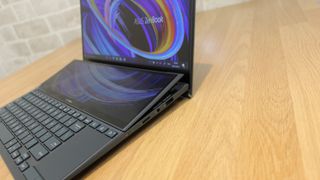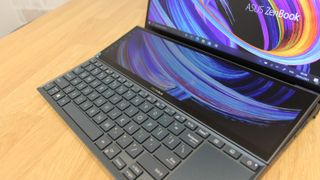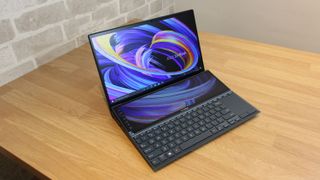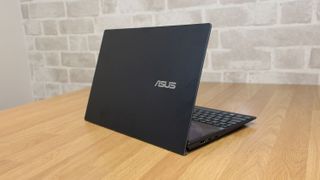IT Pro Verdict
Pros
- +
Great dual-screen design
- +
Solid CPU abilities
- +
Plenty of features
Cons
- -
Ergonomically compromised










The Asus ZenBook Duo 14 UX482 is the latest version of one of Asus’ most innovative machines – a productivity laptop that crams a second touchscreen display into the base. The UX482 takes aim at content creators, and Asus has upgraded the software to make that second display more useful.
Elsewhere, the UX482 goes further than the preceding UX481 in several key areas, with neat design touches and internal upgrades throughout.
It may go beyond its predecessor, but its £1,249 exc VAT price is higher, too – and it faces strong creative competition from rivals like the M1-powered Apple MacBook Pro 13in and the more affordable Honor MagicBook Pro.
Asus ZenBook Duo 14 UX482 review: Design
The UX482 doesn’t look much different from the older Asus, and that’s no bad thing – because the dark blue magnesium alloy still looks great.
Instead of changing the looks, Asus has altered the design of the secondary display. On the older model, opening the laptop deployed the ErgoLift hinge, which pitched the entire base forward at a shallow angle – including the secondary screen. On the UX482, ErgoLift still lifts the base, but the ScreenPad now has its own hinges that lift it even higher, a move which Asus says improves airflow and viewing angles.

Build quality is impressive despite the number of moving parts, and the hinges operate smoothly. The weight of 1.58kg is identical to last year’s model, and Asus has shaved three millimetres off the body for a 16.9mm thickness. That’s impressive for a dual-screen machine with these specs, especially when the competition is considered: the Apple is only a little slimmer and lighter, while the MagicBook is heavier.
Asus ZenBook Duo 14 UX482 review: Keyboard & and trackpad
The second screen also has a huge impact on the keyboard and trackpad. They’re both pushed lower down the chassis, which means there’s no space to rest your wrists while typing. The only change from last year revolves around the layout – the cursor keys have been made smaller to accommodate a larger right-shift key. This is a rare example of a change to the cursor keys which is a good move - the right-shift key is often used while working and was too small on last year’s machine.
In fact, the keys are solid overall, with a pleasing snap and a well-balanced action that combines consistency and comfort. They’re softer than the buttons on rivals, and they’re easily good enough for hours of typing. Meanwhile, the trackpad is decent but it’s too narrow – one swipe doesn’t see the cursor travel all the way across the display.
Both keyboard and trackpad are good enough for daily use, and if you’re going to make frequent use of the ScreenPad then the cramped layout is an acceptable compromise – but rivals are more satisfying.
Asus ZenBook Duo 14 UX482 review: ScreenPad
Happily, the UX482’s upgraded ScreenPad makes those ergonomic compromises more palatable. As before, the ScreenPad is a 12.6 x 3.4in IPS display with a resolution of 1,920 x 515, and Asus has added plenty of functionality on this year’s model.

A new Control Panel app is optimised with sliders, buttons and dials for use in Adobe After Effects, Photoshop, Lightroom and Premiere Pro - these pre-installed settings are already configured with each apps’ most popular shortcuts and options, and can be further customised according to taste. Elsewhere, there are pre-installed, ScreenPad-specific apps for Spotify alongside Asus’ own handwriting and calculator tools, and the MyAsus app has extra software for download - there are utilities for Adobe Acrobat Pro, Dropbox, OfficeSuite, Polaris Office and a handful of others.
The ScreenPad is managed by the Asus ScreenXpert 2 app, which has also been beefed up since last year. It has more options for managing apps and windows - including the ability to save apps into groups if you want to open certain tools simultaneously across both screens - and the option to snap apps to the ScreenPad and switch software between the displays. You can also now customise ScreenXpert 2’s dock with your own shortcuts and position that on any of the ScreenPad’s edges.
As before, the pad can be used as a handwriting or drawing tool, and Asus includes a 4,096-point stylus with this machine. It works well - the display does a solid job of picking up detail and different levels of pressure - but annoyingly, there’s nowhere to store the stylus on the machine.
Overall, this second attempt at the ScreenPad is an improvement on the UX481’s first attempt - there’s more functionality and more third-party app support, with the Adobe dials, buttons and sliders a highlight. And, as before, any app can be used on the ScreenPad. That said, more bespoke third-party support would have been welcome. The ScreenPad’s third-party support still looks a little meagre when compared to Apple’s Touch Bar, which has support for Adobe’s tools alongside Microsoft Office, Final Cut Pro X, Google Chrome and DJ Pro.
The ScreenPad itself offers decent quality levels: its brightness level of 394cd/m2 and its contrast ratio of 1,576:1 are both great results, and they leave the display looking reasonably bright and punchy, with only a little bit of washed-out colour visible thanks to the still-shallow viewing angle. It’s not perfect when it comes to image quality, but the revised angle and the brighter backlight make it far better and more usable than last year’s model.

When it comes to colour accuracy, don’t expect much - the ScreenPad has a Delta E of 3.95. That’s an ordinary result, but this secondary display is designed as a companion rather than as a venue for colour-sensitive work.
Asus ZenBook Duo 14 UX482 review: Display
The main display is a 1080p IPS touchscreen, which means a density level of 157ppi - the same level as the ScreenPad. That’s smart: it leaves the main display sharp enough for work and ensures there are no scaling differences between the two displays.
The main display’s contrast ratio of 1,509:1 is superb and the Delta E of 0.84 is impressive – it means you get accurate colours and loads of vibrancy. The colour temperature of 6,881K is a little cool, but not wayward enough to have a big impact. The main panel handled 93.9% of the sRGB colour gamut – another solid result. It’s a shame that the display only rendered 65.9% of the Adobe RGB gamut, despite the ScreenPad’s Adobe features – while you can get loads of Adobe-based work done on this machine, it won’t handle tasks where accuracy is paramount.
Dell and Apple’s displays are better in some regards: the 4K panel in the latest Dell XPS 13 is brighter and the MacBook has wider DCI-P3 and Adobe RGB gamut abilities. On the other hand, though, neither machine has the second display, and that could be more useful depending on your workloads.
Asus ZenBook Duo 14 UX482 review: Hardware & Performance
The UX482’s Intel Core i7-1165G7 processor has a base speed that veers between 1.2GHz and 2.8GHz depending on the CPU’s thermal headroom, alongside a Turbo peak of 4.7GHz. It’s paired with 16GB of memory, a 512GB Samsung PM981 SSD, and GeForce MX450 graphics. Despite the Nvidia branding, don’t expect much from this chip – it’s barely faster than the CPU’s integrated Iris Xe GPU, and won’t support much beyond photo-editing.

In our benchmarks the Asus delivered an overall score of 122, which is a couple of points faster than the XPS 13 managed with the same chip. That’s an acceptable result, although a closer look proves that Asus’ redesigned chassis works reasonably well when it comes to thermal ability: in a single-core test the CPU ran between 4.1GHz and 4.7GHz and consumed between 18W and 24W of power, and in an all-core benchmark it levelled out at 2.8GHz and consumed 25W. That’s not quite the maximum from this CPU, which has a peak all-core turbo of 4.1GHz and a peak power draw of 28W, but it’s not far off. Temperatures were never too high, either - the underside became warm but never uncomfortable - and noise levels were always quiet.
There’s enough power here to handle everyday workloads, mainstream photo-editing and other content-creation tasks, and it’ll multitask with ease. The SSD helps, too: its read and write speeds of 3,518MB/sec and 3,008MB/sec are impressive.
These results are solid, but this isn’t the best performance around. If you’re not fussed about the ScreenPad and having a super-slim laptop then machines with the AMD Ryzen 5 4600H are available – and that chip scored 229 in our benchmarks in the Honor MagicBook Pro. There’s also the Apple M1, which is used in the MacBook Pro. That chip scored 1,704 and 7,343 in Geekbench 5 – while the ZenBook scored 1,541 and 5,418. Apple’s machine costs £1,415 exc VAT with a specification that matches the UX482, so that’s a little extra cash for a hefty performance leap in multi-threaded tasks.
The Asus bolsters its solid performance with great battery life. In our video rundown test the Asus lasted for 11hrs 35mins with the ScreenPad activated, and deactivating it saw that result improved to 16hrs 17mins. Both results are better than the Dell, and the latter score is much better than the Apple machine. The Asus also lasted for 10hrs and 17mins in an everyday work benchmark.
Those are solid results, but the inclusion of two power-hungry displays and a CPU that can run at higher levels of power consumption means that battery life is dramatically reduced if you engage all of this machine’s talents. We ran a high-end, multi-core work benchmark with the screen at maximum brightness and the UX482 ran out of juice after just 2hrs 33mins. You can expect that figure to rise to four hours if you reduce the display brightness, but it’s still less than ideal.

If you’re careful with the screen brightness and the components, then, you’ll easily get a full day of use from this machine - including some content-creation work, general-purpose use and media viewing - but if you want to push the hardware then you’ll be plugging in before lunchtime.
Asus ZenBook Duo 14 UX482 review: Ports and Features
That’s doubly unfortunate, because although the UX482 has two USB-C ports that are compatible with Thunderbolt 4, one will need to be used to charge the laptop. There’s also one full-size USB 3.2 Gen 1 port – one fewer than last year’s model. Elsewhere, there’s an HDMI output and a microSD card reader.
On the inside, there’s dual-band WiFi 6 and Bluetooth 5.0, but no Ethernet port and no adapter. On the security side, there’s also a 720p webcam that supports Windows Hello and a TPM 2.0 chip.
The UX482’s rivals from Dell and Apple have similar internal features. There are differences on the outside, however: the Dell and Apple have two USB-C ports with Thunderbolt 4, and the Dell has a microSD slot, but neither have HDMI outputs or full-size USB ports.
Asus ZenBook Duo 14 UX482 review: Verdict
The UX482 improves on its predecessor in every way. The ScreenPad is more useful, the machine is slimmer while retaining great build quality and the CPU is faster.
Elsewhere, the UX482 is more mixed. The touch displays offer great quality and versatility, battery life is impressive, and the Asus is cheaper than its rivals, but the second screen hinders comfort, and more performance can be found elsewhere.
If you’re going to make ample use of that second screen, then those compromises are worth it – but if the ScreenPad isn’t a vital addition to your workflow then conventional laptops will deliver a more comfortable experience.
Asus ZenBook Duo 14 UX482 specifications
| Processor | 1.2GHz – 2.8GHz Intel Core i7-1165G7 |
| RAM | 16GB 2,133MHz DDR4 |
| Graphics | Nvidia GeForce MX450 |
| Storage | 512GB Samsung PM981 SSD |
| Display | 14in 1,920 x 1,080 IPS, 12.6iun 1,920 x 515 IPS |
| Operating System | Windows 10 Pro 64-bit |
| Connectivity | Dual-band 802.11ax WiFi, Bluetooth 5.0 |
| Ports | 2 x USB 3.2 Gen 2 Type-C/Thunderbolt 4, 1 x USB 3.2 Gen 1 Type-A, 1 x HDMI, 1 x microSD |
| Dimensions | 324 x 222 x 16.9mm (WxDxH) |
| Weight | 1.58kg |
| Warranty | 1yr RTB |
Mike Jennings has worked as a technology journalist for more than a decade and has been fascinated by computers since childhood, when he spent far too long building terrible websites. He loves desktop PCs, components, laptops and anything to do with the latest hardware.
Mike worked as a staff writer at PC Pro magazine in London for seven years, and during that time wrote for a variety of other tech titles, including Custom PC, Micro Mart and Computer Shopper. Since 2013, he’s been a freelance tech writer, and writes regularly for titles like Wired, TechRadar, Stuff, TechSpot, IT Pro, TrustedReviews and TechAdvisor. He still loves tech and covers everything from the latest business hardware and software to high-end gaming gear, and you’ll find him on plenty of sites writing reviews, features and guides on a vast range of topics.
You can email Mike at mike@mike-jennings.net, or find him on Twitter at @mikejjennings
